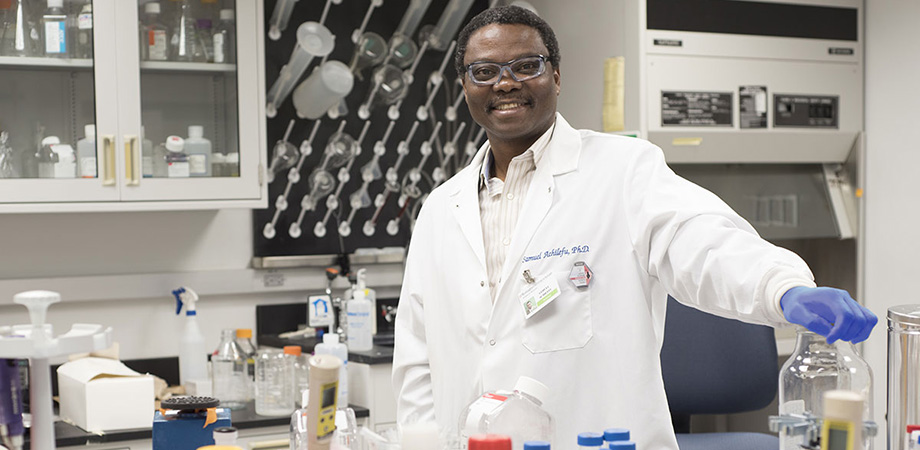Working Together to Improve Global Health
Samuel Achilefu's multidisciplinary approach to translational science wins the 2019 SPIE Britton Chance Award in Biomedical Optics.

Samuel Achilefu's resume of currently held positions—mostly at Washington University School of Medicine—reads like most people's end-of-career summary: professor of radiology, professor of biochemistry and molecular biophysics; professor of biomedical engineering; professor of medicine; chief of an optical radiology laboratory; director of a molecular imaging center; co-leader of an oncologic imaging program. Any one of these roles could be a satisfying career on its own, but Achilefu manages to wear all of these hats at once.
His roles are indicative of his broad research interests, which range from cancer therapy with nanoparticles, to molecular probes for imaging, to technology development for in vivo clinical imaging. These different pursuits require a lot of collaboration: Achilefu's lab pulls together experts in chemistry, molecular and cell biology, biochemistry, physics, engineering, veterinary medicine, pathology, and immunology.
Achilefu finds this interdisciplinary collaboration rewarding. "It is like seeing the whole elephant," he says, "instead of guessing what it looks like by touching only one part of the animal."
This multidisciplinary approach to science with a focus on translatable outcomes has earned Achilefu the 2019 SPIE Britton Chance Award, which is awarded annually in recognition of outstanding lifetime contributions to the field of biomedical optics through the development of innovative, high-impact technologies. The award particularly honors pioneering contributions to optical methods and devices that have facilitated advancements in biology or medicine.
Achilefu's team invented one such innovative device, a head-mounted display that helps surgeons visualize cancer cells during surgeries. His fluorescence goggle system, described in a 2013 paper published in the Journal of Biomedical Optics, incorporates a CMOS sensor and a see-through display that allows the physician to clearly see cancer cells that have been targeted with a molecular agent, making them glow.
The goggles grew out of Achilefu's research around molecular imaging methods, an area of central focus in his lab at Washington University School of Medicine in St. Louis. For example, his lab made the fundamental discovery that radionuclides disintegrate into daughter atoms with entirely different fluorescence enhancing or quenching properties. Copper-64 quenches the fluorescence of near-infrared dyes before it disintegrates into zinc, which, surprisingly, is a fluorescence enhancer, and nickel, which has no effect on fluorescence. This inverse relationship between radionuclide decay and fluorescence enhancement can be used to image the body noninvasively by positron emission tomography (PET), and the fluorescence enhancement generated after the rapid radionuclide decay and potentiated by the daughter atoms can guide real-time surgery in the operating room where radioactivity is not desirable.
Most recently, Achilefu's group discovered a paradigm-shifting contrast mechanism termed dichromic NIR fluorescence that can detect, monitor, and image molecular processes in cells and living organisms. The products of this research are now headed toward commercialization.
But Achilefu is not done yet. Although the Britton Chance Award is given for outstanding lifetime contributions, Achilefu still has a long career ahead of him. His research so far has been focused on improving methods to image and treat cancer, but his next interest is to prevent cancer altogether by developing point-of-care detection kits for use in high- and low-resource areas of the world.
This commitment to improving the global condition is exactly what the Britton Chance Award wishes to recognize. Lihong Wang, director of the Caltech Optical Imaging Laboratory and winner of the 2018 Britton Chance Award, has known Achilefu for more than 15 years, dating from his years at Mallinckrodt Medical, Inc. in St. Louis, where Achilefu co-led the optical imaging project as a principal scientist. "Dr. Achilefu is an outstanding researcher, teacher, and role model with unparalleled academic and research accomplishments," says Wang. "He is most deserving of this award."
Achilefu will be giving the keynote address at BIOS Hot Topics at Photonics West on 2 February 2019 on the topic "Power of Light to See and Treat Cancer." He will discuss his goggle system—a headset paired with a simple fluorescent molecule—that allows surgeons to visualize cancer in the operating room.
| Enjoy this article? Get similar news in your inbox |
|



